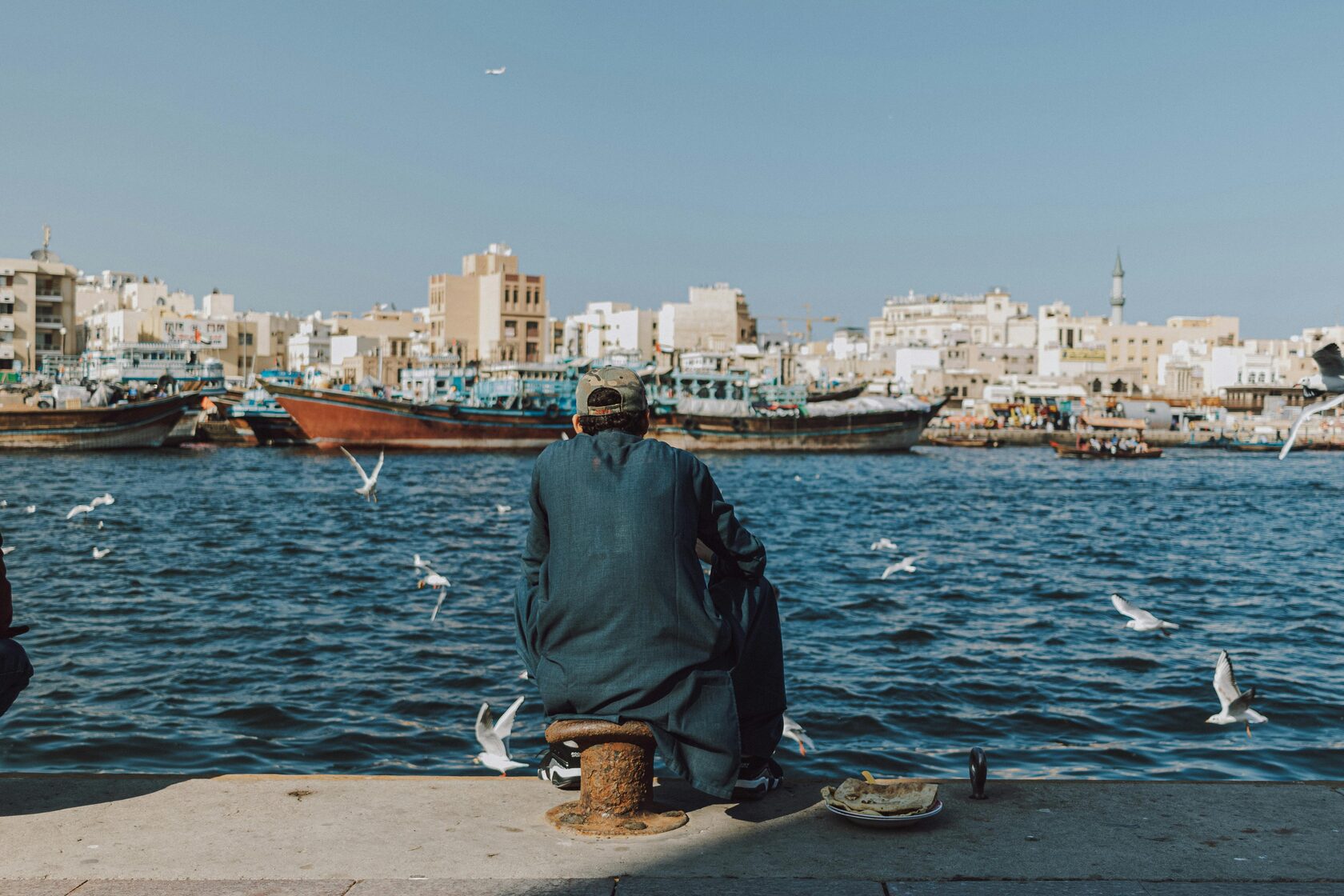Dubai wasn’t always the luxurious city we know it as; the city came from humble beginnings, built on hard work, determination, and trades the early locals mastered. In a city that has grown rapidly, it’s become imperative to preserve the rich heritage and roots; to credit the neighbourhoods where history took place.
The essence of Dubai is not only found in the striking skyline and bold islands, but more so in the foundations laid by the locals that nourished the land through trading pearls, textiles and spices long before the region’s discovery of oil.
The city is very proud of its progress and shows it through a special structure on one of its busiest highways. The Dubai Frame is a symbol of the saying, “Never forget where you come from.” Positioned strategically right at the intersection of old and new Dubai, the frame acts as a symbol of the journey of this fast-paced city. It allows visitors to see the skyscrapers aligned on Sheikh Zayed Road from one side of the frame, and the souks, markets, and mid-rise residentials on the other. It’s an important perspective lens in Dubai’s skyline.
Explore the different historical neighbourhoods that have made Dubai the globally renowned luxury destination that it is today.
The essence of Dubai is not only found in the striking skyline and bold islands, but more so in the foundations laid by the locals that nourished the land through trading pearls, textiles and spices long before the region’s discovery of oil.
The city is very proud of its progress and shows it through a special structure on one of its busiest highways. The Dubai Frame is a symbol of the saying, “Never forget where you come from.” Positioned strategically right at the intersection of old and new Dubai, the frame acts as a symbol of the journey of this fast-paced city. It allows visitors to see the skyscrapers aligned on Sheikh Zayed Road from one side of the frame, and the souks, markets, and mid-rise residentials on the other. It’s an important perspective lens in Dubai’s skyline.
Explore the different historical neighbourhoods that have made Dubai the globally renowned luxury destination that it is today.
Al Fahidi Historical Neighbourhood

Previously named Al Bastakiya, the Fahidi neighbourhood is the oldest part of Dubai and is still conserved, allowing people to be transported back to Dubai’s historic era. The neighbourhood hosts preserved Emirati tradition through art galleries, museums, wind towers and coral-stone buildings dating back to the 19th century.
Al Fahidi has become a place to learn about the Emirati culture, as part of the Dubai Culture & Arts Authority initiative, it includes the following:
Coffee Museum: The museum showcases the global culture of coffee and the art of the perfect brew, especially highlighting the Arabic coffee traditions
Calligraphy House: This gallery showcases the heritage of Arabic calligraphy by taking visitors through the intricacies of the historical art form.
Sheikh Mohammad Centre for Cultural Understanding: This cultural centre offers the unique opportunity to be immersed into Emirati culture. The place offers Emirati meals, cultural conversations, and mosque tours.
Al Fahidi also used to be a thriving market, serving a variety of textiles and pearls; it also typically housed wealthy merchants in its time. The neighbourhood is an ode to traditional Emirati architecture. Currently, Al Fahidi is a hub of cultural and artistic events; hosting several galleries, specialised museums, ceremonies and cultural centres.
Al Fahidi has become a place to learn about the Emirati culture, as part of the Dubai Culture & Arts Authority initiative, it includes the following:
Coffee Museum: The museum showcases the global culture of coffee and the art of the perfect brew, especially highlighting the Arabic coffee traditions
Calligraphy House: This gallery showcases the heritage of Arabic calligraphy by taking visitors through the intricacies of the historical art form.
Sheikh Mohammad Centre for Cultural Understanding: This cultural centre offers the unique opportunity to be immersed into Emirati culture. The place offers Emirati meals, cultural conversations, and mosque tours.
Al Fahidi also used to be a thriving market, serving a variety of textiles and pearls; it also typically housed wealthy merchants in its time. The neighbourhood is an ode to traditional Emirati architecture. Currently, Al Fahidi is a hub of cultural and artistic events; hosting several galleries, specialised museums, ceremonies and cultural centres.
Deira Creekside

This was considered one of the first commercial hearts of old Dubai. To this day, this area hosts various souks including a Gold Souk, Spice Souk, and Perfume (Oud) Souk. Furthermore, since these markets were strategically located along the creek, so visitors and shoppers can experience the trading ports that show off the UAE’s rich Dhow heritage. The Deira creek is a blend of cultures, rich markets and historic mosques, reflecting the beginnings of the UAE.
Other than its commercial aspect, the creek offers beautiful water views; perfect to watch the city’s sunsets from. The creek currently bustles with street vendors, grocers, tailors and local eateries; it’s the best place to learn how Dubai socialised before the malls and skyscrapers. Nowadays, it’s a fantastic tourist spot to immerse visitors into the rich history of Dubai.
Furthermore, the creek also houses Dubai’s classic hotels like the Raddison Blu and Sheraton; both historically relevant as they were the luxury hotspots back in their day.
Other than its commercial aspect, the creek offers beautiful water views; perfect to watch the city’s sunsets from. The creek currently bustles with street vendors, grocers, tailors and local eateries; it’s the best place to learn how Dubai socialised before the malls and skyscrapers. Nowadays, it’s a fantastic tourist spot to immerse visitors into the rich history of Dubai.
Furthermore, the creek also houses Dubai’s classic hotels like the Raddison Blu and Sheraton; both historically relevant as they were the luxury hotspots back in their day.
Al Shindagha Historical District

Image sourced from TimeOut Dubai
Al Shindagha is one of the most historically significant neighbourhoods in the UAE as it is the former residence of the Dubai’s ruling family, the Al Maktoum lineage. Currently, the most well-known landmark in the area is the Al Shindagha Museum which is also known as Sheikh Saeed Al Maktoum House. The museum takes visitors through the rich history of the nation and the early years of pearl-diving and maritime trade that kept the nation afloat.
The museum is divided into three key areas of knowledge; it hosts a perfume house which showcases Emirati perfume formulating traditions, a ‘culture of the sea’ exhibit which showcases Dubai’s maritime history and pearl diving heritage, and finally, the museum also showcases a ‘life on land’ section that displays images from the inception of the UAE and the key landmarks from that era.
Currently, Al Shindagha is a blend of Dubai’s rich history and its modern state. The government has invested into the area to conserve traditional buildings but also launched projects to revitalise the district. This is to allow easier public access to the culturally rich neighbourhood. While it is a quiet neighbourhood, it has that ‘old town charm’ to it with cafés and boutiques decorating its streets.
These Dubai neighbourhoods are an ode to the attitude that’s woven into the fabric of the city; being a country that relied on pearl diving to build its economy, the UAE has risen from the ground up through hard work, dedication, drive, and seizing opportunities.
The museum is divided into three key areas of knowledge; it hosts a perfume house which showcases Emirati perfume formulating traditions, a ‘culture of the sea’ exhibit which showcases Dubai’s maritime history and pearl diving heritage, and finally, the museum also showcases a ‘life on land’ section that displays images from the inception of the UAE and the key landmarks from that era.
Currently, Al Shindagha is a blend of Dubai’s rich history and its modern state. The government has invested into the area to conserve traditional buildings but also launched projects to revitalise the district. This is to allow easier public access to the culturally rich neighbourhood. While it is a quiet neighbourhood, it has that ‘old town charm’ to it with cafés and boutiques decorating its streets.
These Dubai neighbourhoods are an ode to the attitude that’s woven into the fabric of the city; being a country that relied on pearl diving to build its economy, the UAE has risen from the ground up through hard work, dedication, drive, and seizing opportunities.
